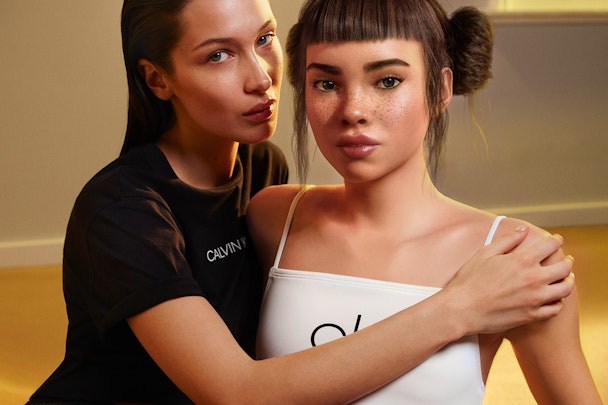Will AI make virtual influencers influential again?
The creative freedom conferred by virtual influencers initially proved irresistible to brands. Could AI’s inevitable influence make them even more so? We take a look as part of The Drum’s latest Deep Dive, AI to Web3: the Tech Takeover.

Lil Miquela, a self-described “19-year-old robot living in LA”, once worked with supermodel Bella Hadid on a Calvin Klein ad
Virtual influencers – or fictional, digital characters that are created by humans and emulate human influencers – have entertained, mystified and disturbed online audiences since first appearing on social media platforms a few years ago.
Like their human counterparts, virtual influencers often garner formidable social media followings, making them common candidates for brand partnerships. Lil Miquela, a self-described “19-year-old robot living in LA”, once worked with supermodel Bella Hadid on a Calvin Klein ad, while Noonouri endorsed Kim Kardashian’s skincare brand Skkn.
So far, it has been well understood that there is a real person behind the scenes pulling the strings on these digital characters, maintaining some sort of line between virtual and human. As emerging AI systems such as Chat-GPT and Dall-E 2 get even more sophisticated, could we see those lines blur?
Advertisement
Virtual influencers: great or gimmick?
Virtual influencers have their own appeal for certain brands seeking to align themselves with modernity and technology – such as Louis Vuitton’s parent company, which created its own virtual brand ambassador and had it present the 2022 finalists of the LVMH Innovation Award.
A virtual influencer also allows brands to broaden their creative horizons. This is due to their ability to “transcend the physical restrictions of human faces, while at the same time remaining rooted in a recognizable reality,” says Becky Owen, chief marketing officer at Billion Dollar Boy, a global influencer marketing agency.
“That means brands can execute unique and sometimes provocative campaigns that catch the eye. Brands love it because of the creative freedom and ownership it gives them, with fewer brand risks attached compared with human influencers. And audiences seem to love it too.”
Whether or not audiences still ”love” virtual influencers is up for debate, with research from influencer marketing software firm Traackr suggesting that their overall allure is fading. Traackr looked at 96 posts from 10 of the top virtual influencers and found an average engagement rate of 0.89%, which is quite low when compared with Euphoria actress Hunter Schafer’s Instagram, for example, and her 13% engagement rate.
“While virtual influencers were buzzy when they popped up a couple of years ago, the attention has definitely waned,” says Evy Lyons, chief marketing officer at Traackr. “Brands are bending over backward to be more authentic and relatable to their customers, working with a wide array of ‘real’ people. Virtual influencers don’t align with those intentions.”
Johan Kristensson, the head of creator success at influencer marketing platform LTK, agrees that investing in virtual influencers is not currently sustainable due to their inability to establish human connections with consumers. He says: “There has been a lot of experimentation among brands with virtual influencers to stand out. And although adopting new technology before your competitors can create talkability, these virtual influencers are not able to portray true authenticity or build the strong connections that real-life creators can make with their audiences.”
Advertisement
A lack of transparency
For now, it’s easy for most online audiences to discern between real and synthetic people online. Many marketers believe that will soon change, however, as artificial intelligence empowers virtual influencers to become more lifelike and autonomous.
As Billion Dollar Boy’s Owen puts it: “It’s inevitable that AI becomes increasingly influential in the way that virtual influencers develop. Currently, they are quite laborious to build and run. They are an art form and take a lot of time for the teams to design assets. With all the innovations we are now seeing in AI, I can imagine it will eventually help to streamline the process and reduce production times.”
Suggested newsletters for you
While virtual influencers become more indistinguishable from humans, a number of ethical concerns could arise – one being the necessity for more formal regulations about disclosing the use of synthetic people in ads. “There needs to be better regulation around this as the industry catches up with the tech,” adds Owen. ”India is the first mover in that regard, becoming the first country to legally enforce transparent labeling on synthetic characters on social media platforms.”
If brands fail to disclose the use of AI, they may also see a breakdown in consumer trust, which can significantly damage their reputations. “Now that AI-generated content is becoming a reality, brands will likely need to disclose when it is used or ensure that virtual influencers with which they collaborate are transparent about being AI rather than real humans,” says Lyons. “No one wants to feel duped and brand reputation will be jeopardized if AI is used secretly.”
Another issue concerns the digital appropriation of minority groups and profiting from it, explains Owen. A consumer may “align with – and, in fact, ultimately become influenced by a virtual influencer’s content and messaging – but the producer behind the VI themselves could be a completely different gender, race or orientation,” she says.
Such was the case with FN Meka, an AI “SoundCloud rapper” that was dropped from Capitol Records in August of 2022 for allegedly reinforcing racial stereotypes. Given that none of its creators were Black, some critics called the character “digital blackface” at the time.
Entering the age of avatars
If the fate of virtual influencers hangs in the balance, another type of virtual creator may soon take their spotlight. Enter avatars, defined as computer-generated characters that portray real humans. Avatars have existed for decades on gaming platforms including Second Life and The Sims, but new tools and studios such as VTube are allowing human creators to live stream themselves to online audiences behind avatars instead of their own faces.
“These VTubers are becoming extremely popular in countries such as Japan and I’m sure it’s only a matter of time before they’re popular everywhere,” says Mishi McDuff, the founder and CEO of metaverse clothing brand House of Blueberry. ”I think VTube is the perfect example of how blurry the line between virtual and real-life influencers is becoming.”
While the credibility and integrity of virtual influencers have been questioned in the past, avatars might allow brands to interact in the digital space in more authentic, credible ways. “With avatars, there’s more accountability as the identity of the owner is a direct, digital representation of your real-life identity,” says Lyons. “However, that might mean there’s less scope for creativity with avatars compared with virtual influencers.“
For more on the latest happenings in AI, web3 and other cutting-edge technologies, check out The Drum’s latest Deep Dive – AI to Web3: the Tech Takeover. And don’t forget to sign up for The Emerging Tech Briefing newsletter.

